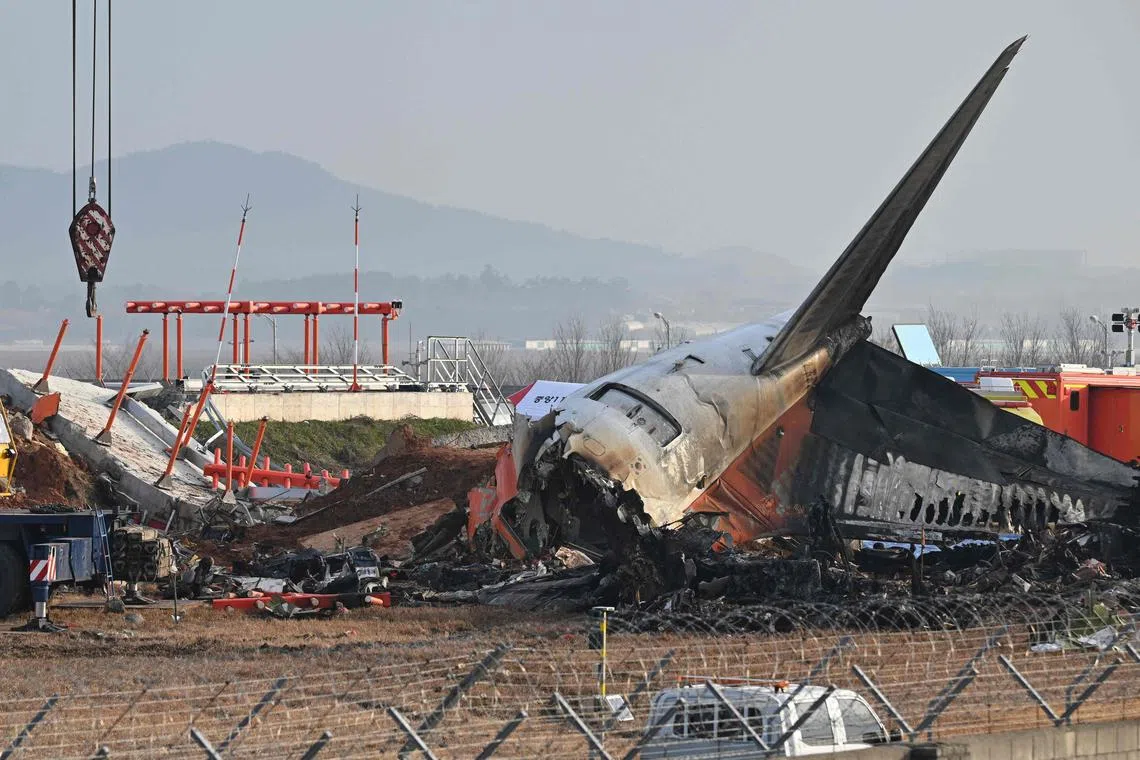Two plane crashes lead to deadliest year in the skies since 2018
Sign up now: Get ST's newsletters delivered to your inbox

The location where a Jeju Air Boeing 737-800 crashed and burst into flames at Muan International Airport as seen on Dec 30.
PHOTO: AFP
Follow topic:
NEW YORK – Commercial aviation suffered its deadliest year since 2018 after the Dec 29 Jeju Air disaster in South Korea downing of an Azerbaijan Airlines plane
Fatalities on board passenger aircraft jumped to 318 in 2024 with the two recent accidents, data compiled by Cirium shows. That is by far the highest death toll since more than 500 people died in 2018, a year marked by the first of two Boeing 737 Max crashes.
The year 2024 started and ended with tragedies in Japan and South Korea during attempted landings, among the most dangerous phases of flight.
Fatal aviation accidents remain very rare, and one major incident can suddenly turn a statistically safe year into one of the worst.
“The recent spike falls into the margins of unpredictability,” said Mr Darren Straker, a former head of air accident investigation units in the United Arab Emirates and Hong Kong. He suggested airline crews could be better trained to respond to so-called outlier events.
Investigators have yet to determine why the Jeju Air Boeing 737-800 – a predecessor to the Max – careered down the runway at Muan International Airport on Dec 29 with no landing gear deployed and smashed into a concrete wall.
All but two of the 181 people on board died as the wrecked jet exploded into a ball of fire.
The fatal Jeju Air crash was the airline’s first and ranks as the worst civil air accident in South Korea.
As the plane neared the airport, one of the pilots reported a bird strike, declared a mayday and initiated a fly-around procedure, according to South Korean Transport Ministry officials.
The plane then turned back and attempted to land in the opposite direction, with the barrier in its path at that end of the runway.
While it seems increasingly evident a bird strike was an “initiator of this tragic chain of events”, what happened next is less clear, said Mr Jeff Guzzetti, a former accident investigation chief for the US Federal Aviation Administration.
Key questions include why flaps that could have slowed the plane down were not extended, and why the landing gear was not lowered, Mr Guzzetti said. If birds damaged both of the engines, that could have caused a loss of power affecting those other systems, he added.
“If you have both engines out – or even one engine – there is going to be lots of cautions and warnings and bells and whistles going off in the cockpit,” he said. “And that can really challenge a flight crew.”
While the Jeju Air aircraft was almost entirely destroyed, investigators will have valuable data to work with as they reconstruct the event. The cockpit voice recorder and the damaged flight data device hold crucial clues to the movements of the jet and the actions and state of the pilots.
After another Jeju plane experienced a landing-gear issue
Boeing shares fell 1.8 per cent as at 1.08pm in New York, bringing its 2024 decline to 32 per cent.
In January, a huge Japan Airlines jet collided with a coast guard plane at Tokyo’s Haneda Airport.
The year was also marred by a case of severe turbulence in May on a Singapore Airlines jet flying over Myanmar,
In July, a plane of Nepal’s Saurya Airlines crashed after taking off from Kathmandu, killing 18.
And in August, dramatic footage of a plane operated by Brazilian airline Voepass captured the turboprop free falling from the sky after encountering icy weather conditions. That accident killed 62.
Global conflicts may also have contributed to 2024’s aviation fatalities. The Azerbaijan Airlines Embraer 190 had nearly completed a scheduled flight from the capital city of Baku to Grozny, Russia, on Dec 25 when it was suddenly diverted across the Caspian Sea.
The damaged plane crashed about 3km from its destination of Aktau, Kazakhstan. Azerbaijan President Ilham Aliyev has said the plane was accidentally shot down by Russia.
The spike in fatalities marks a reversal from 2023, which became the safest year ever in aviation with no deaths among large passenger jetliners – typically planes made by Airbus and Boeing.
Airline safety has been improving for decades as regulators, manufacturers and carriers incorporate lessons learnt to minimise accidents and improve the chances of survival when things go wrong.
Fire-repelling designs on the carbon-hulled Airbus A350 involved in January’s Tokyo crash, for example, combined with near-flawless execution by the Japan Airlines crew and rescue team to allow all 379 people on board to survive.
It is best to look at aviation safety over decade-long periods, said Mr Jan-Arwed Richter, an aviation safety consultant who runs the Jacdec research site in Hamburg, Germany.
“I’m pretty confident that 2024 may be regarded as an outlier in years to come.” BLOOMBERG

